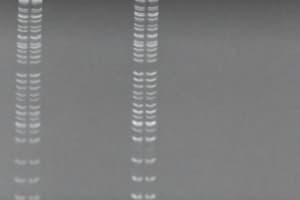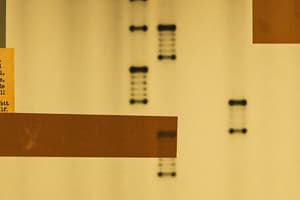Podcast
Questions and Answers
What role does the alkali solution play in Southern blotting?
What role does the alkali solution play in Southern blotting?
- It enhances the signal for autoradiography
- It denatures the DNA into single strands (correct)
- It removes unbound DNA from the membrane
- It binds DNA to the nitrocellulose membrane
What is the primary purpose of Southern blotting?
What is the primary purpose of Southern blotting?
- To detect specific DNA sequences (correct)
- To visualize lipids in biological samples
- To analyze protein structures
- To identify RNA sequences in a sample
Which of the following steps is NOT involved in the Southern blotting process?
Which of the following steps is NOT involved in the Southern blotting process?
- Hybridization with RNA probes (correct)
- Baking the nitrocellulose membrane
- Denaturation of DNA into single strands
- Electrophoresis of DNA samples
Why is autoradiography performed after membrane washing in Southern blotting?
Why is autoradiography performed after membrane washing in Southern blotting?
What is a key advantage of using Southern blotting in genomic analysis?
What is a key advantage of using Southern blotting in genomic analysis?
What is the primary purpose of the southern blot technique?
What is the primary purpose of the southern blot technique?
Which process helps in detecting mutated genes in genetic disorders?
Which process helps in detecting mutated genes in genetic disorders?
What is the role of diizotization in northern blotting?
What is the role of diizotization in northern blotting?
What does PAGE stand for in the context of protein analysis?
What does PAGE stand for in the context of protein analysis?
Which of the following techniques is used to study RNA splicing?
Which of the following techniques is used to study RNA splicing?
Flashcards
What is Southern blotting?
What is Southern blotting?
Southern blotting, a technique involving electrophoresis, transfer to a nitrocellulose membrane, and hybridization with a labeled DNA probe, enables the identification of specific DNA sequences within a complex genomic sample.
How is DNA prepared for Southern blotting?
How is DNA prepared for Southern blotting?
In Southern blotting, DNA is first isolated and digested with restriction enzymes, then separated by size through gel electrophoresis. The DNA fragments are then denatured and transferred to a nitrocellulose membrane.
What is the role of the probe in Southern blotting?
What is the role of the probe in Southern blotting?
A single-stranded DNA probe, labeled with a radioactive isotope (e.g., 32P), is used to hybridize to the transferred DNA fragments. The probe binds specifically to its complementary sequence through base pairing.
How is the DNA sequence detected after probe hybridization?
How is the DNA sequence detected after probe hybridization?
Signup and view all the flashcards
What are the applications of Southern blotting?
What are the applications of Southern blotting?
Signup and view all the flashcards
Southern Blot
Southern Blot
Signup and view all the flashcards
Northern Blot
Northern Blot
Signup and view all the flashcards
Western Blot
Western Blot
Signup and view all the flashcards
DNA probe
DNA probe
Signup and view all the flashcards
Restriction Fragment Length Polymorphism (RFLP)
Restriction Fragment Length Polymorphism (RFLP)
Signup and view all the flashcards
Study Notes
Blotting Techniques
- Blotting techniques are used for analyzing DNA, RNA, and proteins
- The lecture discusses Southern, Northern, Western, and Dot blot techniques.
Southern Blotting
- Southern blotting is the first blotting technique, making analysis and recording easy.
- It identifies DNA fragments with specific sequences.
- DNA fragments are separated by electrophoresis, then transferred to nitrocellulose, and hybridized with a 32P-labeled single-stranded DNA probe.
- The fragment containing the sequence is then visualized by autoradiography
- Procedure:
- DNA sample is digested with a restriction enzyme and electrophoresed.
- DNA bands in the gel are denatured into single strands using an alkali solution.
- The gel is placed on top of a buffer-saturated filter paper on a solid support (e.g., glass plate).
- A nitrocellulose filter membrane is placed on top of the gel and a stack of papers.
- Capillary action pulls the buffer through the gel, the transfer medium, and up through the paper towel stack.
- Nitrocellulose membrane with single-stranded DNA bands is baked at 80°C for 2-3 hours to permanently fix DNA.
- DNA fragments are probed for the sequence of interest using hybridization.
- The membrane is then washed to remove unbound DNA.
- X-ray film is exposed to the membrane to get autoradiographs.
Southern Blotting Applications
- Extremely sensitive for mapping restriction sites around a single copy gene sequence in a complex genome (e.g., human).
- Useful for forensic purposes when using mini-satellite probes for identifying minute DNA amounts.
- Used to analyze the role of DNA methylation in gene expression.
- Used for detecting mutated genes in genetic disorders.
Northern Blotting
- Northern blot procedure is similar to Southern blotting, but RNA is analyzed instead of DNA.
- RNA species are separated by size using electrophoresis through agarose gel with formaldehyde or glyoxal and dimethyl sulfoxide.
- Separated RNA bands are blotted onto chemically reactive filter paper.
- RNA species are then hybridized to radiolabeled DNA probes.
- Auto radiography is used to locate RNA that's complementary to the probe.
- Applications:
- Used for detection and quantitative estimation of hybridized mRNA.
- Used to study RNA degradation, RNA half-life, and RNA splicing.
- Useful in studying gene expression.
Western Blotting
- Western blotting is used for detecting proteins with particular specificity.
- When a transferred gene expresses in transformed cells, the translated protein product can be identified by this technique.
- Procedure:
- Proteins are isolated or extracted.
- Extracted proteins are subjected to polyacrylamide gel electrophoresis (PAGE), and transferred onto nitrocellulose.
- Radiolabeled specific antibody is added to the membrane, binding only to complementary proteins.
- Antibody is labeled with 125I, and the signal is detected by autoradiography.
- If radiolabeling isn't used, a second antibody tagged with an enzyme can be used.
Western Blotting Applications
- HIV confirmatory test detects anti-HIV antibody in human serum.
- Definitive test for Bovine spongiform encephalopathy (BSE, "mad cow disease").
- Confirmatory test for Hepatitis B infection.
Dot Blot Technique
- Used to detect the presence of a given sequence of DNA/RNA (non-fractionated).
- DNA from many samples can be tested in a single test.
- Simplification of Northern, Southern, and Western blotting methods; biomolecules aren't separated by electrophoresis.
- Procedure:
- A mixture containing the molecule to be detected is applied directly as a dot on a membrane.
- The dot is spotted through circular templates on the membrane or paper.
- Detection is done by nucleotide probes (for Northern/Southern) or antibodies (for Western).
Dot Blot Applications
- Detecting Chlamydia-trachomatis infection and other STDs.
- Detecting anti-diacyltrehalose antibodies in Tuberculosis and Typhoid Fever patients.
Studying That Suits You
Use AI to generate personalized quizzes and flashcards to suit your learning preferences.




